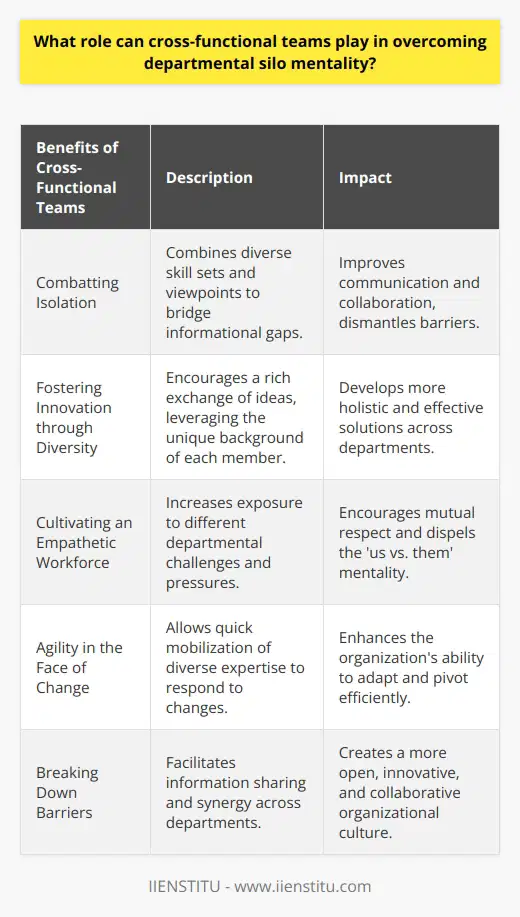
A product leader's role is essential in today's competitive business landscape. Departmental silos can lead to inefficiencies and a lack of coordination, resulting in a product that does not meet customer needs. The product leader must ensure that all departments are working together to create a unified strategy and product, requiring strong communication skills and an understanding of how each department works. Developing a coordinated strategy involves identifying the people in each department that need to be influenced, understanding each department's objectives, setting clear expectations, providing feedback, and communicating regularly.
Introduction
Challenges of Departmental Silos
The Role of the Product Leader
Developing a Coordinated Strategy
Conclusion
Introduction: In today’s competitive business landscape, organizations need to be agile and responsive to the needs of their customers. As organizations grow, departments often become siloed, with each department focusing on its priorities and objectives. This can lead to inefficiencies and a lack of coordination between departments, resulting in a product that does not meet customer needs. As a product leader, it is your job to ensure that all departments work together to create a unified strategy and product. This article will discuss the challenges of departmental silos, the role of the product leader, and how to develop a coordinated strategy.
Challenges of Departmental Silos
Departmental silos can create several challenges for product leaders. When departments are siloed, they are often focused on their objectives, leading to a lack of coordination between departments. This can cause delays in product development, as departments are not working together to create a unified strategy. Additionally, departments may not have the necessary context to understand how their decisions will affect other departments, leading to inefficiencies and a product that does not meet customer needs.
The Role of the Product Leader
As a product leader, it is your job to ensure that all departments work together to create a unified strategy and product. You must see the big picture and understand how each department’s decisions will affect the product. You must also be able to influence each department to ensure that they are working together to create a coordinated strategy. This requires strong communication skills and an understanding of how each department works.
Developing a Coordinated Strategy
Developing a coordinated strategy requires the product leader to identify the people in each department that need to be influenced. Understanding each department’s objectives and how they will affect the product as a whole is essential. Once this is understood, the product leader can ensure that each department works together to create a unified strategy. This includes setting clear expectations, providing feedback, and communicating regularly.
Conclusion: Departmental silos can lead to inefficiencies and a lack of coordination, resulting in a product that does not meet customer needs. As a product leader, it is your job to ensure that all departments work together to create a unified strategy and product. This requires strong communication skills and an understanding of how each department works. By developing a coordinated strategy, the product leader can ensure that all departments work together to create a successful product.
Leadership is about connecting people and ideas, not creating walls between departments.
Related Course: Online Leadership Course
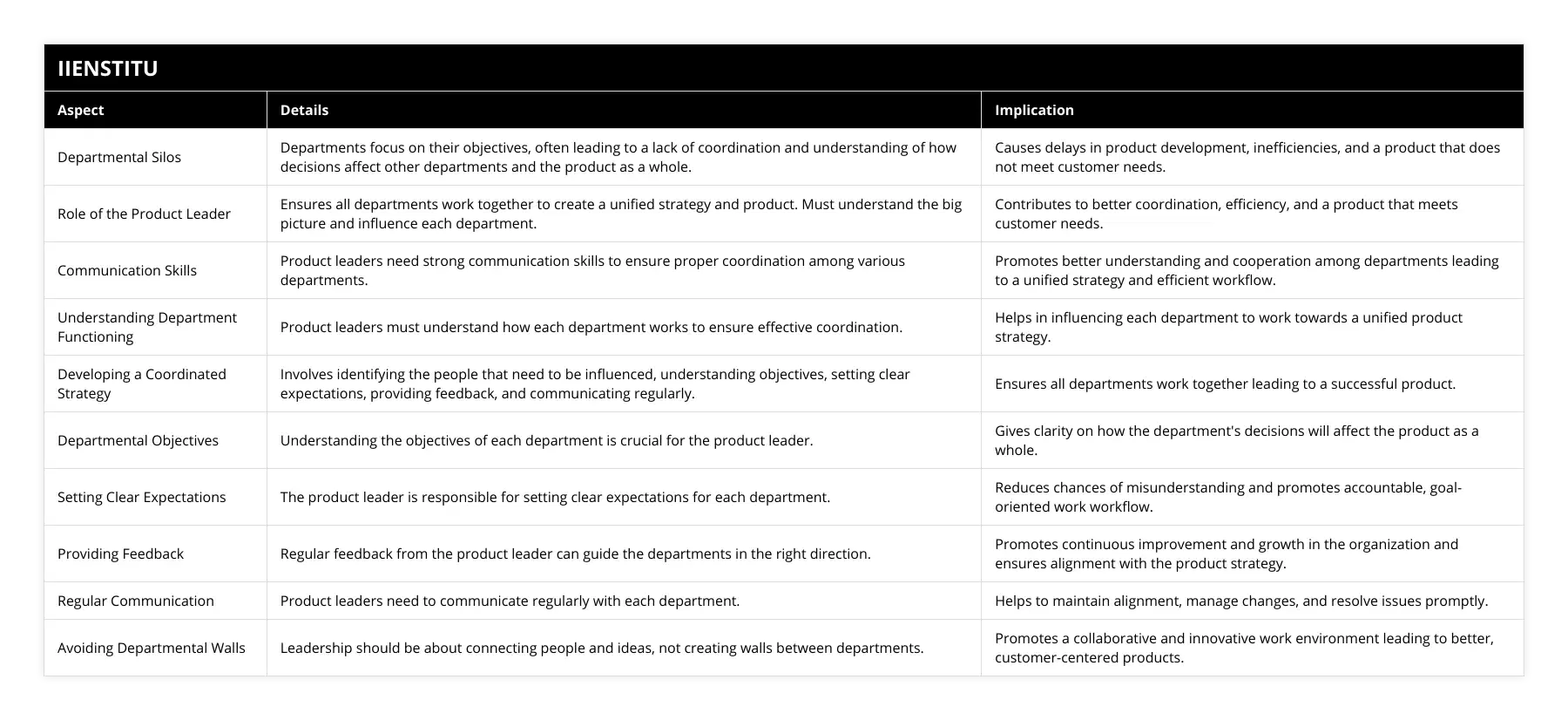
Frequently Asked Questions
What strategies can be used to break down departmental walls in a leadership role?
When leading a complex organization with many departments, breaking down departmental walls and fostering collaboration can be challenging. This is often due to a lack of communication, understanding, and trust between departments. When these walls exist, it can make it difficult for leaders to achieve organizational goals. To break down these walls, leaders should utilize various strategies that focus on building relationships, understanding different roles and perspectives, and developing shared goals.
First, leaders should focus on building relationships and fostering trust between departments. This can be done by encouraging open communication and collaboration between departments. Leaders should also ensure that departments have opportunities to work together on projects and initiatives. This will help to develop relationships and understanding between departments, which can help to break down walls.
Second, leaders should strive to understand different roles and perspectives across departments. This can be done by taking the time to learn about the different roles within each department and the goals and objectives of each team. By understanding the other parts, leaders can better identify areas of collaboration and create shared goals.
Finally, leaders should work to develop shared goals across departments. This can be done by creating a shared vision and purpose that all departments can work towards. Leaders should also create opportunities for departments to collaborate on projects and initiatives. This will help to foster collaboration and break down departmental walls.
By utilizing these strategies, leaders can effectively break down departmental walls and foster collaboration within their organization. By building relationships, understanding different roles and perspectives, and developing shared goals, leaders can ensure that their organization can reach its goals.

How can product leaders create a coordinated strategy to ensure successful collaboration between departments?
Product leaders must develop a well-coordinated strategy to achieve successful collaboration between departments. This strategy should include three key components: alignment of objectives, effective communication, and strong leadership.
Alignment of Objectives
Product leaders should ensure that the objectives of each department are aligned with the organization's overall goals. This will help ensure that departments collaborate efficiently and effectively because they all work towards the same purpose. To ensure that objectives are aligned, product leaders should meet with representatives from each department to discuss their goals and objectives. This will help product leaders identify gaps in dreams and address them before collaboration begins.
Effective Communication
Product leaders should create a communication plan that outlines how departments will communicate with each other. This plan should include clear and consistent guidelines for how departments should sound and how long it should take for departments to respond to each other. Product leaders should also ensure that departments have the resources and tools to facilitate effective communication.
Strong Leadership
Product leaders should provide strong leadership to ensure successful collaboration between departments. This means setting clear goals and expectations, communicating regularly with all departments, and providing positive reinforcement when goals are achieved. Product leaders should also be willing to make difficult decisions when necessary and be open to feedback from all departments.
By developing a well-coordinated strategy that includes alignment of objectives, effective communication, and strong leadership, product leaders can create the conditions for successful collaboration between departments. This will help organizations achieve their goals more efficiently and effectively and ultimately lead to more successful products.

What are the benefits of breaking down departmental walls in a leadership role?
Organizations that employ effective leadership models are often the most successful. The traditional hierarchical model of departmental walls has long been the standard for many organizations. However, a new trend has emerged in recent years: breaking down departmental barriers in leadership roles. This approach has numerous benefits that can help organizations achieve tremendous success.
One benefit of breaking down departmental walls in leadership roles is fostering greater collaboration between departments. By removing the barriers between departments, leaders can more easily collaborate and share ideas. This leads to faster decision-making and better communication between departments. This improved collaboration can result in better customer service, increased productivity, and improved organizational efficiency.
Breaking down departmental walls in leadership roles can also result in increased creativity. With fewer barriers, leaders can more easily explore new ideas and concepts. This encourages creativity, leading to more innovative solutions and better problem-solving. This greater creativity can result in improved products or services, higher customer satisfaction, and increased profits.
Furthermore, breaking down departmental walls in leadership roles can lead to higher employee engagement. When leaders are open to new ideas and collaboration, employees feel more valued and engaged in their work. This can lead to higher employee satisfaction, which can lead to improved job performance and loyalty.
Finally, breaking down departmental walls in leadership roles can improve organizational culture. By eliminating the barriers between departments, leaders can create a more unified culture that encourages collaboration and innovation. This improved culture can improve employee morale and loyalty, increasing productivity and profitability.
In conclusion, breaking down departmental walls in leadership roles can benefit organizations. It can foster greater collaboration, encourage creativity, improve employee engagement, and improve organizational culture. Organizations that employ this approach can reap the rewards of these benefits, leading to tremendous success.
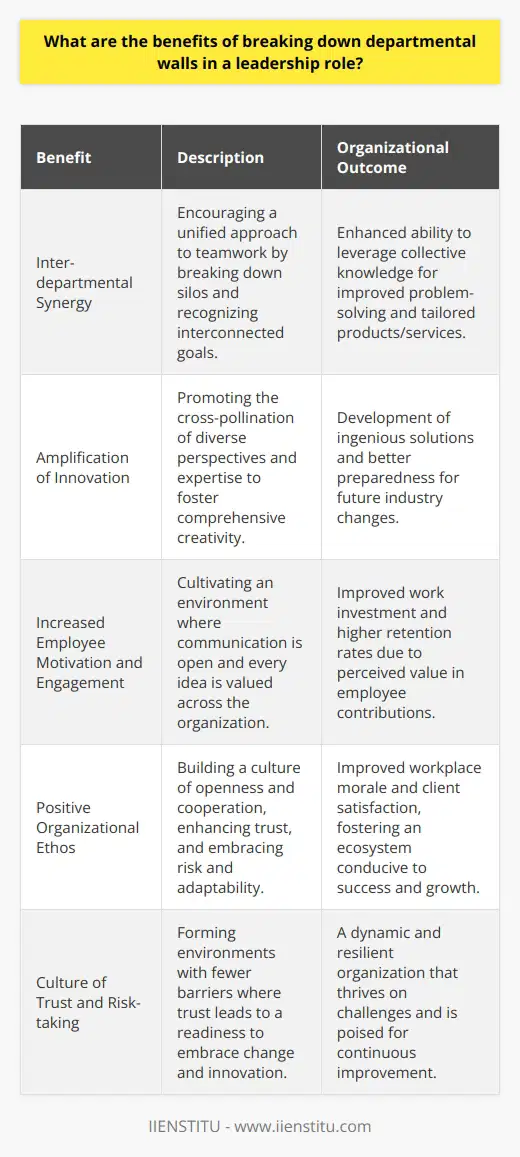
What are the key indicators of a silo mindset within an organization?
Understanding Silo Mentality
To identify a silo mindset within an organization, one must first understand its characteristics. A silo mindset often showcases through a lack of cross-departmental collaboration. Departments behave as separate entities, much like silos on a farm, with limited communication or information sharing.
Departmental Isolation
One clear sign of a silo mindset is departmental isolation. Teams and departments within the organization fail to collaborate or share resources. This leads to inefficiency and missed opportunities for innovation. The resultant lack of collective problem-solving compromises company growth.
Limited Knowledge Sharing
Another key indicator is limited knowledge sharing. In an organization with a silo mindset, employees usually withhold information or keep knowledge within their own department. This hampers the ability of others to perform their roles effectively and slows overall organizational learning.
Strict Hierarchical Structure
Frequent signs of a silo mindset also include an overly rigid and hierarchical structure. Employees at the lower rungs feel disempowered to voice opinions or engage in decision-making. This creates a disconnect between management and staff, leading to an 'us versus them' mentality.
Competition Over Collaboration
An organization may also engender a silo mindset if it encourages inter-departmental competition instead of collaboration. While healthy competition can drive performance, excessive rivalry fosters hostility and resentment. This deters teamwork and discourages mutually beneficial collaboration.
Resistance to Change
A final key indicator is resistance to change. A siloed organization often resists new ideas, clinging to outmoded ways of doing things. In the long run, this stymies innovation and obstructs the organization's ability to adapt to changing realities.
Conclusion
Recognizing these signs within your organization can empower leaders to take necessary steps towards breaking down silos. Addressing these issues not only enhances internal communication but also fosters a culture of collaboration and inclusion. Such efforts are key to an organization's ongoing success and sustainability.
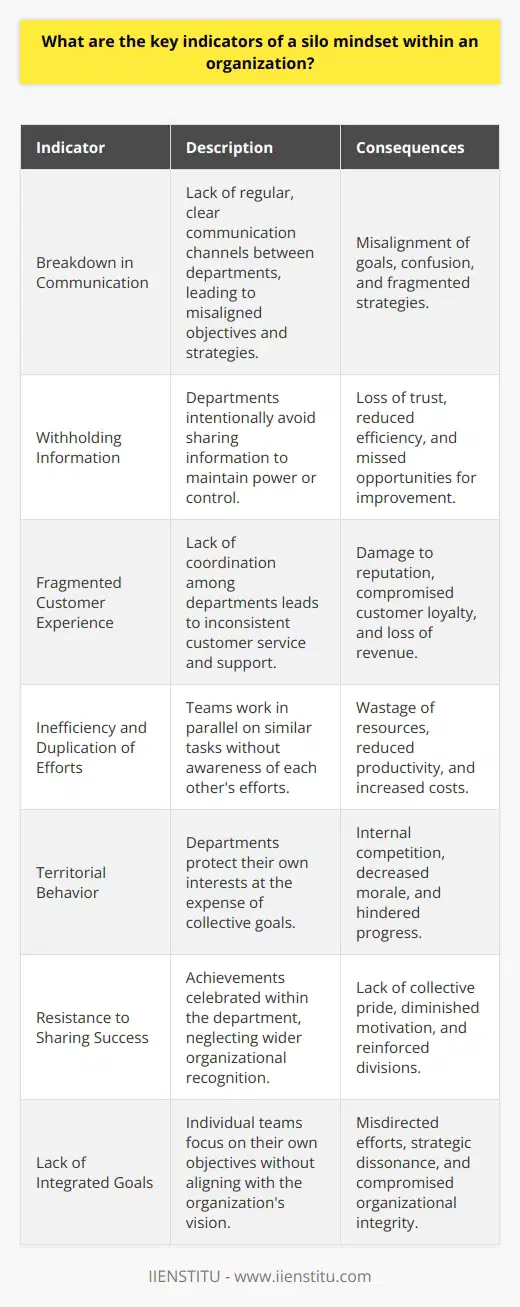
How can breaking down silos enhance overall organizational effectiveness and innovation?
Breaking Down Silos for Enhanced Organizational Effectiveness
Organizational effectiveness thrives on open communication. Silos, defined as isolated teams or departments within an organization, hinder this crucial factor. Therefore, breaking down these silos can significantly enhance overall effectiveness.
Promoting Cross-Functional Teams
Promoting cross-functional teams is one strategy for dismantling organizational silos. These teams consist of members from different departments working towards a common goal. This offers the chance to combine diverse skills and expertise, bringing a more comprehensive approach to problem-solving.
Fostering a Culture of Collaboration
Developing a culture of collaboration can also aid in overcoming silos. Encouraging teams to share ideas, knowledge, and resources helps reduce isolation and promotes a sense of belonging. In a collaborative environment, employees can feel more invested in the organization's success.
Encouraging Open and Frequent Communication
Effective communication plays an integral role in breaking down silos. Regular meetings, both formal and informal, promote dialogue between departments. They facilitate the exchange of ideas, paving the path for innovation.
Implementing Integrated Technology Systems
Another way to tackle silos is through the implementation of integrated technology. Shared platforms for communication and project management can connect isolated departments, fostering collaboration and enhancing efficiency.
Breaking Silos to Promote Innovation
Innovation thrives in an environment devoid of silos. The shared knowledge can spark fresh ideas, while diverse perspectives can challenge traditional ways of thinking. This is conducive for fostering innovation, leading to the creation of new products, services, or processes.
In conclusion, breaking down silos can enhance overall organizational effectiveness and innovation. It encourages collaboration, boosts communication, and facilitates the exchange of diverse ideas and perspectives. This not only improves efficiency but also provides a breeding ground for innovation.
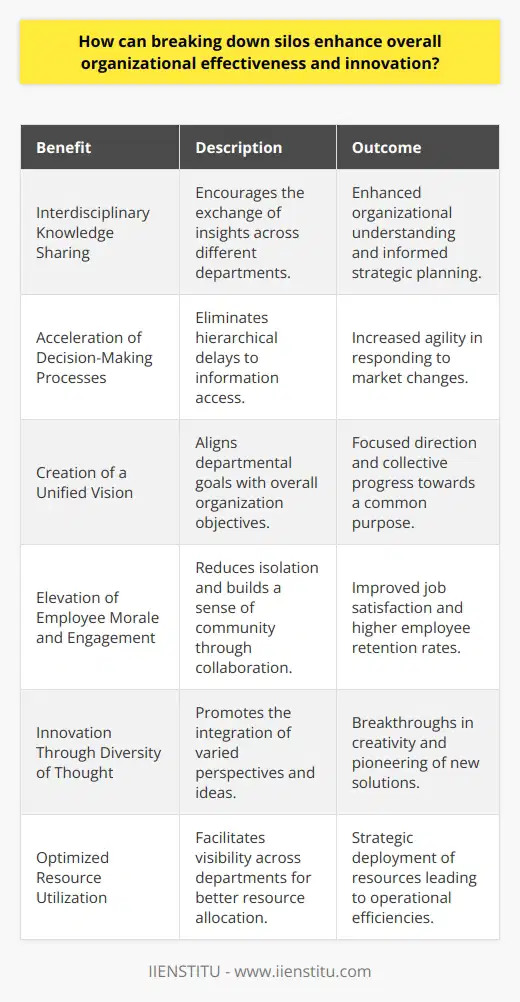
What role can cross-functional teams play in overcoming departmental silo mentality?
Cross-Functional Teams as a Solution
Cross-functional teams have a significant role in overcoming departmental silo mentality. They encourage collaborative efforts. By integrating representatives from different departments, they break down the walls of the 'silo.'
Breaking the Barriers
These teams combat the isolation that silo mentality often fosters. They ensure that employees from different departments work closely on projects. This proximity facilitates communication and cooperation, which reduce misunderstandings and conflict.
Sharing Perspectives
Cross-functional teams also promote the sharing of perspectives. Team members view issues from different angles, fostering innovation and problem-solving. They drive more comprehensive, inclusive decisions.
Building Empathy
Moreover, working in cross-functional teams increases empathy among team members. By knowing each other's roles and challenges better, employees become more understanding. This understanding discourages blame-shifting and fosters a supportive culture.
Enhancing Flexibility
Finally, cross-functional teams enhance organisational flexibility. By pulling together skills and expertise from different departments, they boost the organization's ability to adapt to change.
Thus, cross-functional teams play a transformative role in overcoming the problems associated with departmental silo mentality. By promoting collaboration, shared perspectives, empathy, and flexibility, they assist in breaking down the rigid walls of silos.
